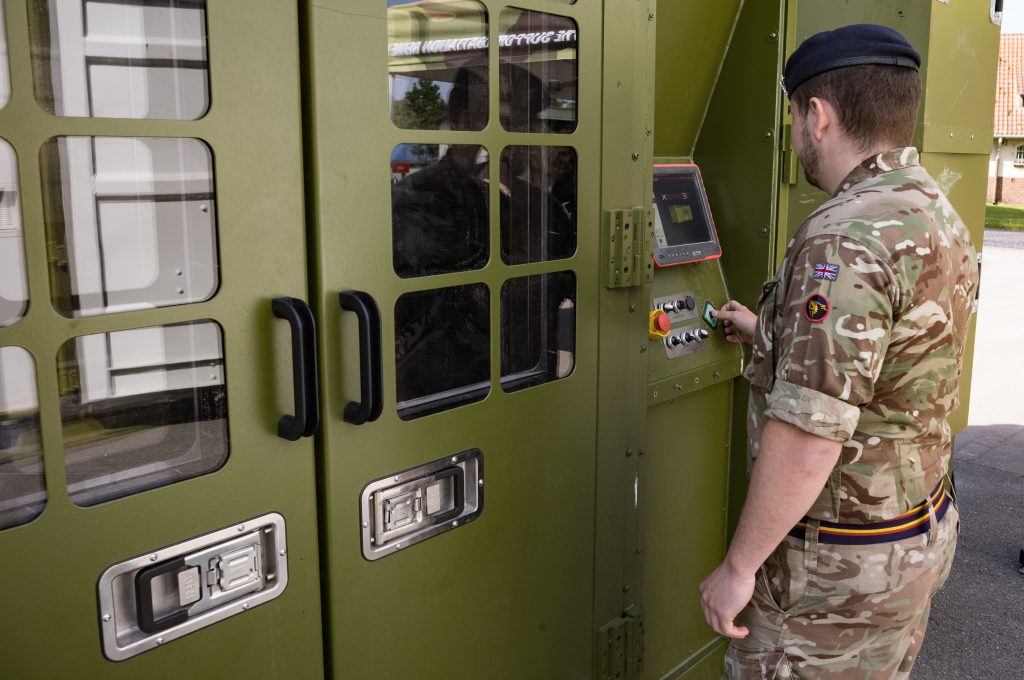Where better to understand the opportunities for additive manufacturing in aerospace, space, and defense than an organization tasked with securing the future of American manufacturing?
Ahead of Additive Manufacturing Advantage: Aerospace, Space & Defense, I spoke to MxD’s Daniel Reed about modernizing the industrial base, emerging 3D printing technology, and business opportunities.
Daniel Reed’s career path in aerospace and manufacturing showcases an unusual yet insightful trajectory. Starting in small manufacturing companies, Reed’s early experiences were marked by entrepreneurial opportunities.
Reed’s roles involved a diverse range of responsibilities from sales to design, highlighting his hands-on approach. Transitioning to a system integrator and OEM, Reed encountered a steep learning curve, managing a team where his youngest report was over two decades his senior. He admits, “I was pretty sure that I was smarter and knew better than them. And I was pretty wrong,” illustrating the humility gained through practical challenges, such as a sheet metal design issue that fundamentally changed his perspective on manufacturing processes.
Reed brings these formative business experiences to his current position as Manager of Technical Programs at MxD, a public-private partnership aimed at enhancing US manufacturing competitiveness through digital manufacturing and cybersecurity initiatives. His role involves scoping projects, writing funding proposals, and acting as a technical lead. Reed emphasizes the collaborative nature of MxD, stating, “We do a lot of our technical projects in collaboration with our members. They bring a lot of the technical heft, I may sit over the top and guide positions or do project management, for example.”

Strengthening U.S. economic prosperity and national security
The Manufacturing USA network or the National Network for Manufacuring Innovation has 17 institutes, led by Department of Defense (DoD) and Department of Energy (DOE) for the U.S. government. Readers may be more familiar with America Makes in terms of work in the additive manufacturing industry. Reed highlights key distinctions between his organization and American Makes, emphasizing MxD’s broader focus on digital manufacturing and cybersecurity. “American Makes has a very specific focus on additive,” he noted, underscoring MxD’s role in creating tools and infrastructure that apply to various manufacturing processes and organizations, including non-manufacturers involved in data exchange.
One collaboration aims to tackle the complexity of additive manufacturing qualification and certification. Reed described this effort as addressing the significant challenge where additive manufacturing’s promise of distributed, flexible production is hindered by lengthy qualification processes. Currently, it can take up to 18 months to qualify an additive part, despite the capability to print and test it in weeks. Reed stressed, “The industry problem here is that additive is complex. You’re making the material form at the same time as you’re making the geometry.”
The collaboration integrates process monitoring, integrated computational materials engineering (ICME), and AI/machine learning to create a more efficient qualification process. This model-driven approach aims to produce parts that are “born certified.” Reed explained, “We want to know enough about them and how they were made, and what makes them good versus bad.” By leveraging expertise from American Makes in additive, LIFT in materials engineering, and MxD’s digital infrastructure, the initiative seeks to ensure parts can be certified immediately upon production.
Reed also pointed out the extensive collaboration necessary for this initiative, involving industry, academia, and various stakeholders from machine makers to powder suppliers. This comprehensive approach aims to refine the qualification process, moving away from traditional, time-consuming methods to a more modern, efficient system.
Integrating additive manufacturing into aerospace applications: challenges and opportunities
The integration of additive manufacturing technologies into aerospace applications is progressing, yet presents significant challenges and opportunities. A primary hurdle remains in testing and validation, particularly ensuring that produced components meet rigorous standards without extensive testing. “Additive is very good in aerospace. It can produce geometries that were previously impossible,” Reed highlighted, noting its potential in high-heat environments, lightweight structures, and orphaned component replacements in defense systems.
A key application of additive manufacturing in defense is the production of small quantities of complex parts, especially when original manufacturers no longer exist. Reed explained, “How do you efficiently produce small quantities of parts that have this complex geometry and you might only need a few of them a year, without spending half a million dollars on tooling?” This approach could maintain the viability of small manufacturers within the defense industrial base, crucial for sustaining the supply chain.
Additive manufacturing, with its prospect for adaptive logistics, can benefit significantly here while simultaneously enhancing national security. For example, current supply chains are constructed around peacetime operations. Lessons from COVID and the ongoing Ukraine war should illustrate that such links cannot be taken for granted. Increasingly, with supply chain strength viewed strategically and as a crucial element of defense deterrence, a trade-off between value for money and resilience is apparent.
Reed also discussed the emerging concept of “production contested logistics,” which involves deploying additive manufacturing systems in shipping containers to produce parts on-demand in conflict zones. This logistics approach allows for temporary part replacements until permanent solutions can be delivered. “The idea is to stream manufacturing information securely to produce replacement parts at the point of need,” Reed elaborated. Some information about such a solution has already been released, for example, the seven metal 3D printers supplied by SPEE3D to Ukraine or efforts by U.S. Army. Others take the view that a containerized solution detracts from a broader process-based approach that would be more beneficial.
Additionally, Reed pointed out the use of additive-enabled processes, where additive manufacturing is employed to create tooling or molds for traditional manufacturing, thereby enhancing efficiency without altering the final product’s certification requirements. This method sidesteps some qualification hurdles while leveraging additive’s capabilities to streamline production processes. Technologies like cold spray and wire arc additive manufacturing are already being used for in-situ repairs, further demonstrating the practical applications of these innovations.

Emerging additive manufacturing technology
Our conversation turned the emerging technologies in additive manufacturing with the potential to transform aerospace applications. Reed highlighted multi-material 3D printing as a significant advancement, allowing the creation of single parts with varied material properties. He explained, “You can have copper in one place for conductivity and Inconel elsewhere for heat resistance,” enhancing functionality without brute-force methods like explosion welding.
Another notable development is dissolvable supports for metal additive parts. This innovation mimics the dissolvable supports used in polymer printing. By altering the chemical properties of a metal part’s surface layer, supports can be dissolved away without damaging the main part. Reed noted, “You print the part slightly oversized, then dip it in a chemical solution to change just the outer layer. Then an acid bath strips away the supports.”
Reed also mentioned an emerging technology where chemical reactions are printed at the nozzle, creating raw material at the precise location needed. This method could potentially overcome the limitations of current techniques that rely on melting or binding powders.
MxD is very active in its collaborative efforts within the aerospace sector, emphasizing partnerships that leverage advanced technologies to address industry challenges. Reed highlighted a project with Boeing and universities where laser systems and compensation algorithms were used to enhance robotic precision. This collaboration resulted in a new standard submitted to NIST.
MxD also plays a critical role in modernizing the Department of Defense’s organic industrial base. The organization evaluates facility problems, proposes industry solutions, and manages projects to bridge gaps between industry and the DoD. “We bring on our industry members to propose solutions, evaluate them, and help manage the project to the end,” Reed noted.
A notable collaboration involves using AI and large language models to automate VR and AR content creation for maintenance and remote servicing. This project aims to reduce the high costs of producing AR content by connecting disparate systems and integrating various data sources. Reed stated, “We fund this project to use AI and large language models to dramatically accelerate the production of AR content.”
Looking forward, Reed sees significant growth in additive manufacturing (AM) for aerospace and defense, driven by advances in qualification and certification processes. He predicts that solving these issues will unlock opportunities for small businesses to bid on replacing legacy components. “The qualification certification problem will be solved or more meaningfully addressed within the next couple of years,” Reed asserted.
Reed also anticipates continued development of new materials specifically designed for additive processes. He cited NASA’s recent development of an aluminum alloy for additive manufacturing, illustrating the trend of creating bespoke materials tailored for AM. “We are getting to the place where computation and AI are able to really help do autonomous experimentation,” Reed said, predicting this will accelerate the development of new materials and expand AM applications.
Reed summarized the advantages of additive manufacturing for aerospace and defense as encompassing the ability to produce complex geometries, reduce weight, and facilitate the efficient production of small quantities of parts, particularly orphaned components. These advancements, he believes, will enhance the capabilities and competitiveness of the aerospace and defense sectors.
MxD, is at the forefront of a revolution in aerospace and defense manufacturing. Learn more at our July 16th online event: Additive Manufacturing Advantage: Aerospace, Space & Defense.
To stay up to date with the latest 3D printing news, don’t forget to subscribe to the 3D Printing Industry newsletter or follow us on Twitter, or like our page on Facebook.
While you’re here, why not subscribe to our Youtube channel? Featuring discussion, debriefs, video shorts, and webinar replays.


